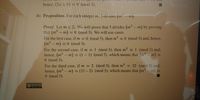
Algebra & Trigonometry with Analytic Geometry
13th Edition
ISBN: 9781133382119
Author: Swokowski
Publisher: Cengage
expand_more
expand_more
format_list_bulleted
Concept explainers
Topic Video
Question
I've been stuck on this one for a while.
If the proposition is false, and the proof is incorrect, find the error in the proof and provide a counter example showing that it is false
If the proposition is true, but the proof is wrong, fix the proof
If everything is correct, nothing needs to be done

Transcribed Image Text:hence, (2a +b) = 0 (mod 3).
(b) Proposition. For each integer m, 5 divides (m - m).
Proof. Let m e Z. We will prove that 5 divides (m – m) by proving
that (m-m) = 0 (mod 5). We will use cases.
For the first case, if m = 0 (mod 5), then m5 = 0 (mod 5) and, hence,
(m – m) = 0 (mod 5).
For the second case, if m = 1 (mod 5), then m = 1 (mod 5) and,
hence, (m5- m) = (1– 1) (mod 5), which means that (ms- m) =
0 (mod 5).
For the third case, if m = 2 (mod 5), then m5
hence, (m3 - m) = (32- 2) (mod 5), which means that (m - m) =
0 (mod 5).
= 32 (mod 5) and,
BY NC SA
Expert Solution
This question has been solved!
Explore an expertly crafted, step-by-step solution for a thorough understanding of key concepts.
This is a popular solution
Trending nowThis is a popular solution!
Step by stepSolved in 2 steps

Knowledge Booster
Learn more about
Need a deep-dive on the concept behind this application? Look no further. Learn more about this topic, advanced-math and related others by exploring similar questions and additional content below.Similar questions
Recommended textbooks for you
- Algebra & Trigonometry with Analytic GeometryAlgebraISBN:9781133382119Author:SwokowskiPublisher:Cengage
 College Algebra (MindTap Course List)AlgebraISBN:9781305652231Author:R. David Gustafson, Jeff HughesPublisher:Cengage Learning
College Algebra (MindTap Course List)AlgebraISBN:9781305652231Author:R. David Gustafson, Jeff HughesPublisher:Cengage Learning Algebra: Structure And Method, Book 1AlgebraISBN:9780395977224Author:Richard G. Brown, Mary P. Dolciani, Robert H. Sorgenfrey, William L. ColePublisher:McDougal Littell
Algebra: Structure And Method, Book 1AlgebraISBN:9780395977224Author:Richard G. Brown, Mary P. Dolciani, Robert H. Sorgenfrey, William L. ColePublisher:McDougal Littell

Algebra & Trigonometry with Analytic Geometry
Algebra
ISBN:9781133382119
Author:Swokowski
Publisher:Cengage

College Algebra (MindTap Course List)
Algebra
ISBN:9781305652231
Author:R. David Gustafson, Jeff Hughes
Publisher:Cengage Learning

Algebra: Structure And Method, Book 1
Algebra
ISBN:9780395977224
Author:Richard G. Brown, Mary P. Dolciani, Robert H. Sorgenfrey, William L. Cole
Publisher:McDougal Littell